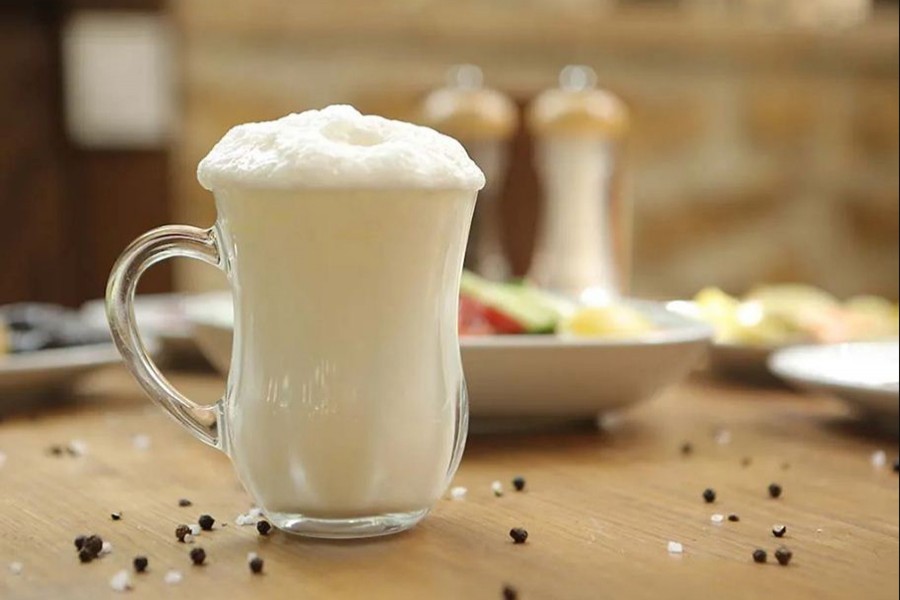Lassi is a yoghurt based sweet and sour chilled refreshing drink. It is enjoyed throughout the year but is particularly popular during the scorching summer months.
And if you are talking about the holy month of Ramadan, Lassi becomes a household name to quench the thirst after day-long fasting.
Lassi is an ancient drink that is probably one of the first smoothies ever invented. It is thought to have originated approximately 1000 BC in Punjab and Multan, India. It is well-known for its ability to calm the stomach and mind.
Making lassi at home
Making lassi is easy as it requires minimal ingredients. Most common are sweet lassi and salted lassi.
To make lassi, you only need yoghurt, water and sugar if needed. Then this mixture is either blended or manually mixed. This is the most basic way of making lassi. Adding some fruits like banana, and mango can make it more delicious.
Make your own version of lassi
Some other types of lassi are made by adding salt, spices, mint, coriander leaves and ginger if you want to make your lassi tangy and spicy. You can bring variation by experimenting with your lassi.
Don’t be afraid to mix your favourite seasonal nuts, dry fruits and fresh fruits such as - strawberry, papaya, lychee etc. or a combination of different fruits also sounds great.
Some different flavours like vanilla, caramel, coffee or chocolate lassi can also be prepared. Lemon zest can add some powerful lemon flavour to it. Instead of sugar, honey can be added to make it healthier.
The combinations are boundless, so play with it and customise your lassi as per your taste.
Lassi in South Asian countries
India: Plain lassi is a common beverage in Northern India, particularly in Punjab and Haryana. They drink lassi from tall, large steal glasses and serve it to their guests. There are numerous famous places in India that serve delicious lassi.
Among other types of lassi, the most unique lassi which Indian people have is bhang lassi. Bhang lassi is a cannabis-infused drink. It is legal in many regions of India and is offered during the Holi festival.
Pakistan: Kesar Lassi is the best lassi to try in Pakistan. Kesar Lassi is served with a few Kesar strands and tastes like flavoured milk.
In Pakistan, when it comes to lassi, you can get it from any milk shop, but only a handful of them taste great.
Bangladesh: In Bangladesh, lassi is pronounced as ‘lachchhi’. Sweet lassi is mostly eaten by Bangladeshi people. They serve it in regular sized glasses. It is usually made of sweet yoghurt.
Many shops sell lassi in Bangladesh, but few match the authentic taste of Lassi. One of the most popular and liked lassi in the country is Beauty Lassi of Old Dhaka.
Health benefits
Drinking cold and refreshing lassi is a centuries-old tradition. Because it is both delicious and healthy. It is rich in proteins and helps develop muscle strength in the body. It is high in calcium, which contributes to the development of strong bones and teeth.
Lassi helps in the healthy functioning of the body's digestive system. Yoghurt is a natural probiotic that facilitates the development of healthy bacteria in the body. It even reduces the number of harmful germs in the stomach.
Lassi is a great drink for gaining energy after 12/13 hours of fasting and it also has a great aftertaste. It has a reputation for decreasing blood pressure and cholesterol levels in the body.
Lassi is a natural remedy for a wide range of stomach problems. Drinking a glass of lassi first thing in the morning can help your stomach stay healthy for the rest of the day.
A refreshing and chilled glass of lassi never fails to rehydrate the body. Since it is simple to make, try to include it in your iftar and explore different preparation methods.


